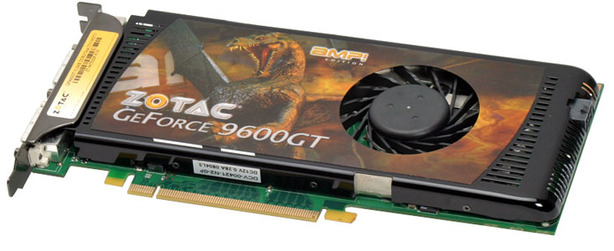Test Setup
As always, we did our best to deliver a clean set of benchmarks, with each test repeated three times and an average of those results is what we’re reporting here. In the rare case where performance was inconsistent, we continued repeating the test until we got three results that were consistent.Graphics cards
- Zotac GeForce 9600 GT 512MB AMP! Edition – operating at 725/1,750/2,000MHz using Forceware 174.12 beta
- Nvidia GeForce 9600 GT 512MB – operating at 650/1,625/1,800MHz using Forceware 174.12 beta
- Nvidia GeForce 8800 GT 512MB – operating at 600/1,500/1,800MHz using Forceware 169.28
- Asus EN8800GS/HTDP/384M – operating at 550/1,375/1,600MHz using Forceware 169.32 WHQL
- Nvidia GeForce 8600 GTS 256MB – operating at 675/1,450/2,000MHz using Forceware 169.28
- ATI Radeon HD 3870 512MB – operating at 775/2,250MHz using Catalyst 8.1 WHQL
- PowerColor Radeon HD 3850 Xtreme PCS 512MB – operating at 720/1,800MHz using Catalyst 8.1 WHQL
- ATI Radeon HD 3850 256MB – operating at 670/1,660MHz using Catalyst 8.1 WHQL
- ATI Radeon X1950 Pro 256MB – operating at 580/1,400MHz using Catalyst 8.1 WHQL
Common Components
Intel Core 2 Duo E6750 (operating at 2.66GHz – 8x333MHz); Gigabyte GA-X38-DS5 motherboard (Intel X38 Express); 2x 1GB OCZ FlexXLC PC-9200 memory (operating in dual-channel at DDR2-800 with 4-4-4-12 timings); Seagate Barracuda 7200.9 160GB SATA hard drive; PC Power & Cooling Silencer 750W PSU; Windows Vista Ultimate x86; Intel inf 8.3.0 WHQL.
Games Tested
We used the following versions of the games listed to evaluate the performance of these video cards:- Crysis, version 1.1.1.5879 (patch 1.1) with DirectX 10 and DirectX 9.0
- Call of Duty 4: Modern Warfare, version 1.4 with DirectX 9.0
- Unreal Tournament 3, version 1.1 with DirectX 9.0
- Supreme Commander, version 3280 with DirectX 9.0
- The Elder Scrolls IV: Oblivion, version 1.2 with DirectX 9.0
- Enemy Territory: Quake Wars, version 1.4.0

MSI MPG Velox 100R Chassis Review
October 14 2021 | 15:04









Want to comment? Please log in.